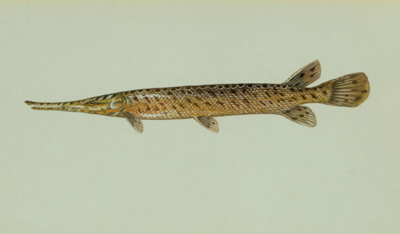Editor’s note: The Courier Express, in collaboration with Lola M. Smith, MS, lecturer in biology at Penn State DuBois, is republishing a series of work completed by college students about endangered species in Pennsylvania. References for the work, similar to a college research paper, are credited at the end for each article.
Three species of gars once lived in Pennsylvania, the Shortnose gar (Lepisosteus platostomus), Longnose gar (Lepisosteus osseus), and the Spotted gar (Lepisosteus oculatus) (PFBC 2021 Gar). As of today, there are only two species of gars that are residing in Pennsylvania with the Shortnose gar being extinct. While there is a healthy population for the Longnose gar (Lepisosteus osseus) (Daniel Kelly 2015), Spotted gars are on the Pennsylvania Endangered Species list.
Gars are unique, as their swim bladder connects to the throat by an open tube, and when they are pressed for oxygen, they are able to go to the surface and gulp for air. This acts like a lung for them (PFBC 2021 Gar).
Spotted gars and the Longnose gars are similar, but there are some differences that you can use to tell them apart. Spotted gars and Longnose gars are both olive green on the back, while on the stomach, Spotted gars have a silvery-white belly compared to where the Longnose gar has a white belly. The Spotted gars also have large, round dark spots on the tops and sides of their heads, also on the upper side of their body. The Longnose gar only has spots on their fins and along the rear of their sides.
Spotted gars can be found outside of Pennsylvania, like in the Gulf of Mexico, the lower Great Lakes and the Mississippi watershed. In Pennsylvania, the Spotted gar is only found around the Presque Isle Bay or Lake Erie. They thrive in rivers, and clear, weedy backwaters, and oxbows of low-gradient creeks. Their habitats can also include swamps, sloughs, ditches and lakes. To be able to spawn, Spotted gars needs to be along the lake shores in shallow water or they can spawn under vegetation (PFBC 2021 Gar).
There are two reasons why the Spotted gars are on the list of endangered species in Pennsylvania. First, is that chemicals and nutrients degrade the water quality, and cause an algal bloom that can create an anoxic area during decomposition. Second, invasive species such as the zebra mussels, and other fishes can impact the growth of vegetation and the substrate.
Although the Pennsylvania Fish and Boat Commission says Spotted gars have a stable population, they still have a recovery plan. The public can help by not releasing any non-native species into Lake Erie. You can also help by not fishing where they are found, or if you do fish and catch them, you should always release them since they are an endangered species and are illegal to harvest (PFBC 2021 PFLR).
References
Daniel Kelly, 2015, Gar www.lakescientist.com/lake-facts/fish/gar/. Accessed 29 Aug 2021
Pennsylvania Fish & Boat Commission. 2015. Spotted Gar www.pgc.pa.gov/Wildlife/WildlifeActionPlan/Documents/SWAP-CHAPTER-1-apx14e-fish.pdf. Accessed 28 Aug 2021
Pennsylvania Fish & Boat Commission. 2021. Gar www.fishandboat.com/Fish/PennsylvaniaFishes/GalleryPennsylvaniaFishes/Pages/Gars.aspx . Accessed 29 Aug 2021
Pennsylvania Fish and Boat Commission. 2021. “Pennsylvania Fishing Law & Regulations,” Summary Book- Commonwealth Inland Waters. pfbc.pa.gov/fishpub/summaryad/inland.html. Accessed 28 Aug 2021












